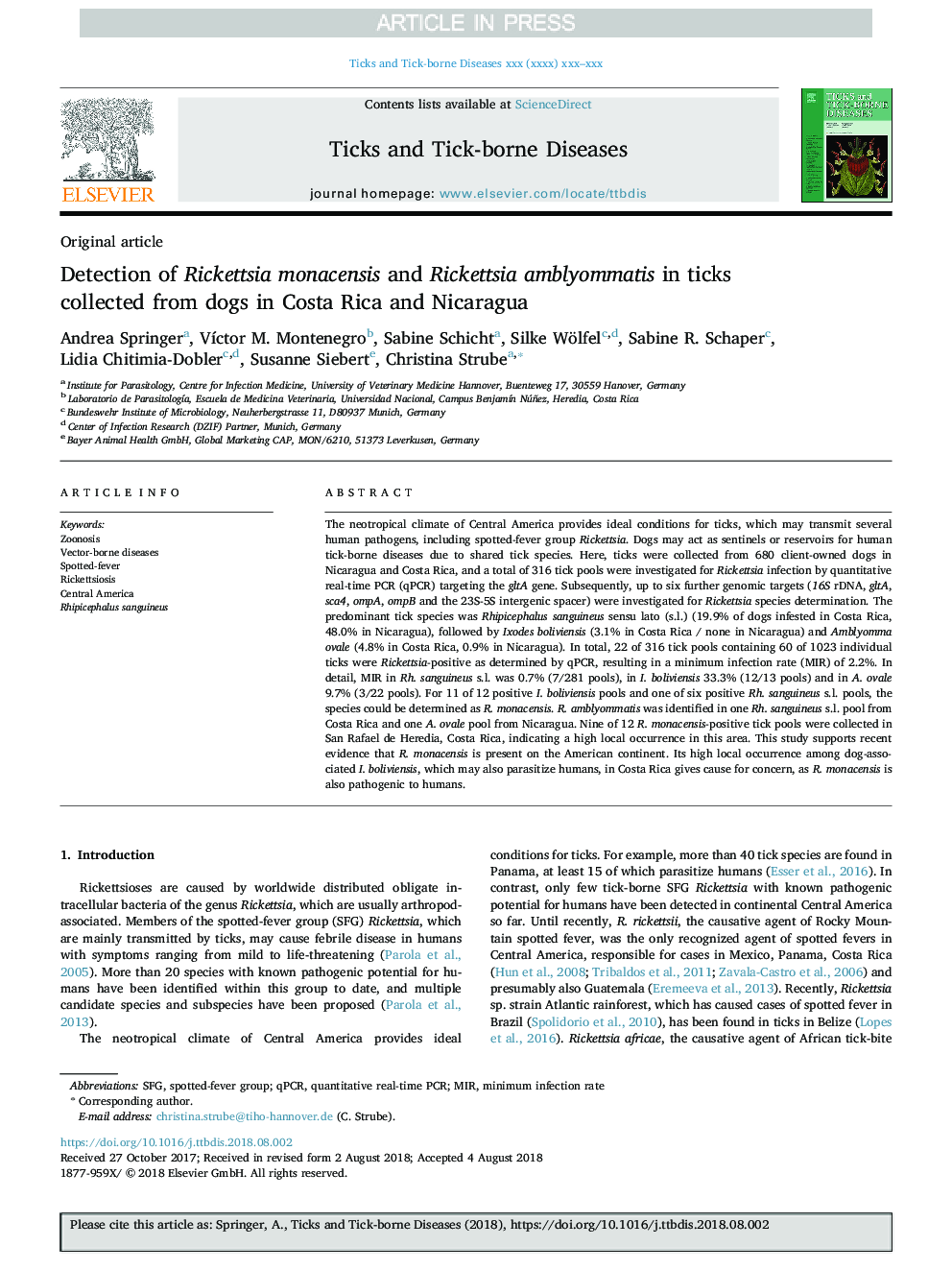| کد مقاله | کد نشریه | سال انتشار | مقاله انگلیسی | نسخه تمام متن |
|---|---|---|---|---|
| 8965646 | 1646730 | 2018 | 8 صفحه PDF | دانلود رایگان |
عنوان انگلیسی مقاله ISI
Detection of Rickettsia monacensis and Rickettsia amblyommatis in ticks collected from dogs in Costa Rica and Nicaragua
ترجمه فارسی عنوان
تشخیص ریکیتیسا موناکانسس و آملیومماتیس ریککتیس در کلیه های جمع آوری شده از سگ ها در کاستاریکا و نیکاراگوئه
دانلود مقاله + سفارش ترجمه
دانلود مقاله ISI انگلیسی
رایگان برای ایرانیان
کلمات کلیدی
موضوعات مرتبط
علوم زیستی و بیوفناوری
علوم کشاورزی و بیولوژیک
علوم دامی و جانورشناسی
چکیده انگلیسی
The neotropical climate of Central America provides ideal conditions for ticks, which may transmit several human pathogens, including spotted-fever group Rickettsia. Dogs may act as sentinels or reservoirs for human tick-borne diseases due to shared tick species. Here, ticks were collected from 680 client-owned dogs in Nicaragua and Costa Rica, and a total of 316 tick pools were investigated for Rickettsia infection by quantitative real-time PCR (qPCR) targeting the gltA gene. Subsequently, up to six further genomic targets (16S rDNA, gltA, sca4, ompA, ompB and the 23S-5S intergenic spacer) were investigated for Rickettsia species determination. The predominant tick species was Rhipicephalus sanguineus sensu lato (s.l.) (19.9% of dogs infested in Costa Rica, 48.0% in Nicaragua), followed by Ixodes boliviensis (3.1% in Costa Rica / none in Nicaragua) and Amblyomma ovale (4.8% in Costa Rica, 0.9% in Nicaragua). In total, 22 of 316 tick pools containing 60 of 1023 individual ticks were Rickettsia-positive as determined by qPCR, resulting in a minimum infection rate (MIR) of 2.2%. In detail, MIR in Rh. sanguineus s.l. was 0.7% (7/281 pools), in I. boliviensis 33.3% (12/13 pools) and in A. ovale 9.7% (3/22 pools). For 11 of 12 positive I. boliviensis pools and one of six positive Rh. sanguineus s.l. pools, the species could be determined as R. monacensis. R. amblyommatis was identified in one Rh. sanguineus s.l. pool from Costa Rica and one A. ovale pool from Nicaragua. Nine of 12 R. monacensis-positive tick pools were collected in San Rafael de Heredia, Costa Rica, indicating a high local occurrence in this area. This study supports recent evidence that R. monacensis is present on the American continent. Its high local occurrence among dog-associated I. boliviensis, which may also parasitize humans, in Costa Rica gives cause for concern, as R. monacensis is also pathogenic to humans.
ناشر
Database: Elsevier - ScienceDirect (ساینس دایرکت)
Journal: Ticks and Tick-borne Diseases - Volume 9, Issue 6, September 2018, Pages 1565-1572
Journal: Ticks and Tick-borne Diseases - Volume 9, Issue 6, September 2018, Pages 1565-1572
نویسندگان
Andrea Springer, VÃctor M. Montenegro, Sabine Schicht, Silke Wölfel, Sabine R. Schaper, Lidia Chitimia-Dobler, Susanne Siebert, Christina Strube,
